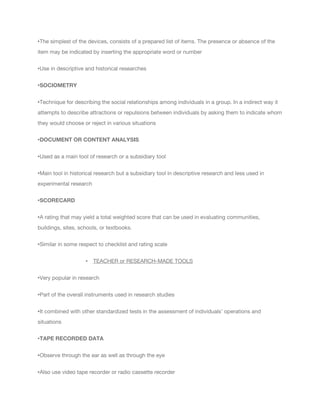Instrument in research
- 1. Introduction: •One of the most important components of a research design is the research instruments because they gather or collect data or information. •These research instruments or tools are ways of gathering data. Without them, data would be impossible to put in hand. •QUESTIONAIRE •The most common instrument or tool of research for obtaining the data beyond the physical reach of the observer which, for ex. May be sent to human beings who are thousands of miles away or just around the corner. •Two Forms of Questionnaire •Closed form / Closed-ended •Open form / Open-ended •Guidelines in Using the Questionnaire •Clarity of language •Singleness of purpose •Relevant to the objective of the study •Correct grammar •Principles to consider in constructing Questionnaire •1. define or qualify terms that could easily be misinterpret •2. be careful in using descriptive adjectives and adverbs that have no agreed-upon meaning •3. be careful of inadequate alternatives •4. beware of double negative
- 2. •5.avoid the double-barreled question •6. underline the word if you wish to indicate special emphasis •7. when asking for rating or comparisons a point of reference is necessary •8. avoid unwarranted assumptions •9. phrase questions so that they are appropriate for all respondents •10.design question that will give a complete answer •11.provide for the systematic qualification of response •12.consider the possibility of classifying the respondents yourself rather than having the respondents choose categories •Advantages •Facilitates data gathering •Is easy to test data for reliability and validity •Is less time-consuming than interview and observation •Preserves the anonymity and confidentiality of the respondents’ reactions and answers •Disadvantages •Printing and mailing are costly •Response rate maybe low •Respondents may provide only socially acceptable answers •There is less chance to clarify ambiguous answer •Respondents must be literate and with no physical handicaps •Rate of retrieval can be low because retrieval itself is difficult
- 3. •INTERVIEW •It is in a sense of an oral questionnaire. Instead of writing the response, the interviewee gives the needed information orally and face-to-face. With a skillful interviewer, the interview is often superior to other data-gathering device. •The purposes of interview are : •- to verify information gathered from written sources •- to clarify points of information •- to update information and •- to collect data •Types of Interview •Structured or standardized •Unstructured or unstandardized •Telephone interview •RATING SCALE •Involves qualitative description of a limited number of aspects of a thing or traits of a person •Forms of Rating Scale •Thurstone Technique •Likert Method •Semantic Differential •CHECKLIST
- 4. •The simplest of the devices, consists of a prepared list of items. The presence or absence of the item may be indicated by inserting the appropriate word or number •Use in descriptive and historical researches •SOCIOMETRY •Technique for describing the social relationships among individuals in a group. In a indirect way it attempts to describe attractions or repulsions between individuals by asking them to indicate whom they would choose or reject in various situations •DOCUMENT OR CONTENT ANALYSIS •Used as a main tool of research or a subsidiary tool •Main tool in historical research but a subsidiary tool in descriptive research and less used in experimental research •SCORECARD •A rating that may yield a total weighted score that can be used in evaluating communities, buildings, sites, schools, or textbooks. •Similar in some respect to checklist and rating scale • TEACHER or RESEARCH-MADE TOOLS •Very popular in research •Part of the overall instruments used in research studies •It combined with other standardized tests in the assessment of individuals’ operations and situations •TAPE RECORDED DATA •Observe through the ear as well as through the eye •Also use video tape recorder or radio cassette recorder
- 5. •OPINIONNAIRE •An information form that attempts to measure the attitude or belief of an individual •Also known as attitude scale •OBSERVATION •Perceiving data through the senses: sight, hearing, taste touch and smell •Most direct way used in studying individual behavior •Types of Observation •Participant and non-participant observation •Structured and unstructured observation •Controlled and uncontrolled observation •PSYCHOLOGICAL TESTS •An instrument designed to describe and measure a sample of certain aspects of human behavior •e.i. performance test, paper and pencil test, achievement inventory, personality inventory and projective devices •READY-to-USE INSTRUMENT or STANDARDIZED TEST •Product of long years of study •tend to be highly reliable and cover a wide range of student performance level •CRITERIA for Measuring Research Instruments •1. Validity- measure what is intends to measure •Types of Validity •Content validity
- 6. •a. expert judgment •b. table of specification •Criterion validity •Construct validity •2. Reliability – stability in maintaining consistent measurement in a test administered twice •Methods in determining the Reliability of a Test •Test-retest method •Alternate or parallel form •Split-half method •Rationale equivalence method •Reason for Conducting a Field Test or Dry-Run •Determine the feasibility and applicability of the study •Validate the instrument to ensure that the data to be collected are valid •Check the reliability of the instrument to ensure that the data collected are reliable and accurate •Ensure efficiency and effectiveness of instrument in gathering the needed data •Ensure that the instrument, say questionnaire, is objective, simple, meaningful, easily administered and adequate in collecting the needed data •Be able to obtain accurate and reliable data in the procedure of investigation •Be able to obtain recommendations and suggestions for the enrichment of the instrument •After pretest or try-out, revision must be made in content structure or format, mechanics and organization before an actual investigation is made






